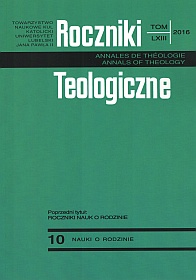Jesus Did Not Start Religious Life; Why Did It Appear in the Church? Biblical Foundation of Consecrated Life
Abstract
This paper examines the biblical foundation of religious life in the context of the history of salvation. It briefly presents the God’s plan of salvation. As historical Israel failed their mission exile was the consequence of this failure. A consequence of the restoration of Israel will be the pilgrimage of the nations to Jerusalem. Jesus’ healing miracles point out that God is restoring his people and that is why he takes away all kind of sickness. The ancient Church knew that it had to be a sign of the truth of the Gospel in its entire existence however, when, after the “Milan edict” of Constantine (312/313 AD), the masses enter the Church, its early structure of “house Churches” was broken. Soon after the monastic movement began. With the monastic communities coming to existence, there was a chance that at least these religious house churches would preserve the community dimension of the Church and that they would continue to be a sign for the pagan society of how God wants his people to live.
References
Alfaro, Juan. “God Protects and Liberates the Poor — O.T.” Concilium 187 (1986): 27–35.
Baker, David L. Tight Fists or Open Hands?: Wealth and Poverty in Old Testament Law. Grand Rapids: Eerdmans, 2008.
Brox, Norbert. “Frühchristliche und heutige Nöte mit der christlichen Gemeinde.” Diakonia 11 (1980): 364–384.
Gribomont, Jean. “Monasticism: Early Christian (to 600).” In New Catholic Encyclopaedia, IX, 1032–1037. Washington, D.C.: Jacke Heraty & Associates 1967. Reprint 1981.
Lohfink, Gerhard. Jesus and Community. The Social Dimension of Christian Faith, translated by John P. Galvin. Philadelphia: SPCK 1984
Lohfink, Norbert. Option for the Poor. The Basic Principle of Liberation Theology in the Light of the Bible. Berkeley: D & F Scott, 1987
Malchov, Bruce V. Social Justice in the Hebrew Bible. Collegeville: Liturgical Press, 1996.
Mulhern, Philip F. “Vow; Practice and Theology of.” In New Catholic Encyclopaedia, XIV, 756–758. Washington, D.C.: Jacke Heraty & Associates 1967. Reprint 1981.
Rapley, Elizabeth. The Lord as Their Portion. The Story of the Religious Orders and How They Shaped Our World. Grand Rapids: Eerdmans 2011.
The Anti-Nicene Fathers of the Christian Church, I-X, edited by Alexander Roberts. Edinburgh – Grand Rapids: 1983-1989.
Shanks, Hershel (ed.). Ancient Israel, A Short History from Abraham to the Roman Destruction of the Temple. Washington: Biblical Archeology Society 1988.
Smith, R.F., “Religious Life.” In New Catholic Encyclopaedia, XII, 287–294. Washington, D.C.: Jacke Heraty & Associates 1967. Reprint 1981.
Copyright (c) 2016 Roczniki Teologiczne

This work is licensed under a Creative Commons Attribution-NonCommercial-NoDerivatives 4.0 International License.





